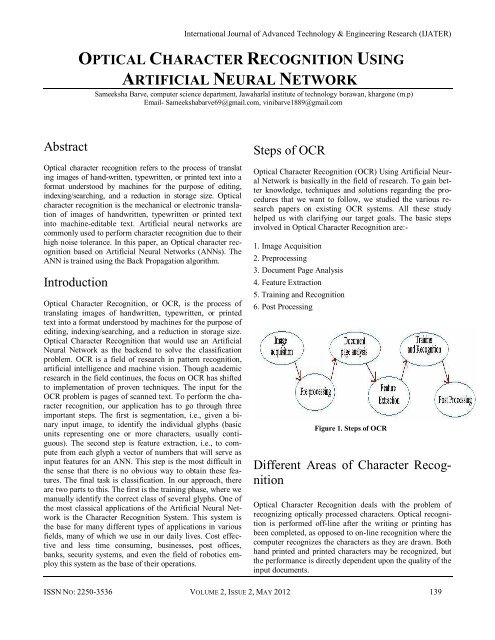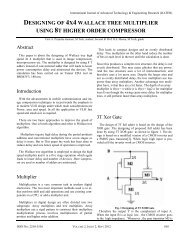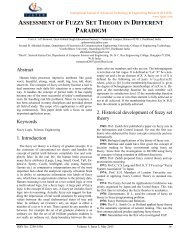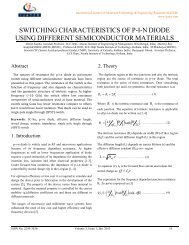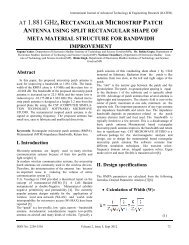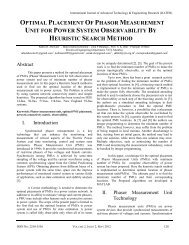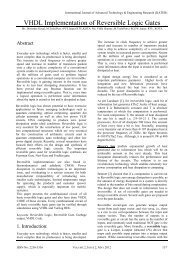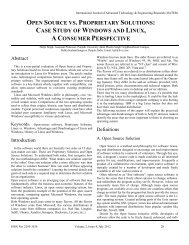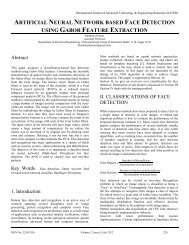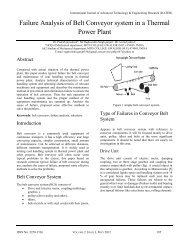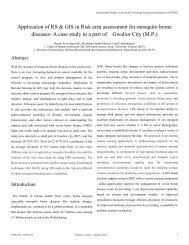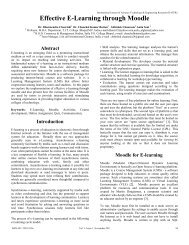optical character recognition using artificial neural network - ijater
optical character recognition using artificial neural network - ijater
optical character recognition using artificial neural network - ijater
Create successful ePaper yourself
Turn your PDF publications into a flip-book with our unique Google optimized e-Paper software.
International Journal of Advanced Technology & Engineering Research (IJATER)<br />
OPTICAL CHARACTER RECOGNITION USING<br />
ARTIFICIAL NEURAL NETWORK<br />
Sameeksha Barve, computer science department, Jawaharlal institute of technology borawan, khargone (m.p)<br />
Email- Sameekshabarve69@gmail.com, vinibarve1889@gmail.com<br />
Abstract<br />
Optical <strong>character</strong> <strong>recognition</strong> refers to the process of translat<br />
ing images of hand-written, typewritten, or printed text into a<br />
format understood by machines for the purpose of editing,<br />
indexing/searching, and a reduction in storage size. Optical<br />
<strong>character</strong> <strong>recognition</strong> is the mechanical or electronic translation<br />
of images of handwritten, typewritten or printed text<br />
into machine-editable text. Artificial <strong>neural</strong> <strong>network</strong>s are<br />
commonly used to perform <strong>character</strong> <strong>recognition</strong> due to their<br />
high noise tolerance. In this paper, an Optical <strong>character</strong> <strong>recognition</strong><br />
based on Artificial Neural Networks (ANNs). The<br />
ANN is trained <strong>using</strong> the Back Propagation algorithm.<br />
Introduction<br />
Optical Character Recognition, or OCR, is the process of<br />
translating images of handwritten, typewritten, or printed<br />
text into a format understood by machines for the purpose of<br />
editing, indexing/searching, and a reduction in storage size.<br />
Optical Character Recognition that would use an Artificial<br />
Neural Network as the backend to solve the classification<br />
problem. OCR is a field of research in pattern <strong>recognition</strong>,<br />
<strong>artificial</strong> intelligence and machine vision. Though academic<br />
research in the field continues, the focus on OCR has shifted<br />
to implementation of proven techniques. The input for the<br />
OCR problem is pages of scanned text. To perform the <strong>character</strong><br />
<strong>recognition</strong>, our application has to go through three<br />
important steps. The first is segmentation, i.e., given a binary<br />
input image, to identify the individual glyphs (basic<br />
units representing one or more <strong>character</strong>s, usually contiguous).<br />
The second step is feature extraction, i.e., to compute<br />
from each glyph a vector of numbers that will serve as<br />
input features for an ANN. This step is the most difficult in<br />
the sense that there is no obvious way to obtain these features.<br />
The final task is classification. In our approach, there<br />
are two parts to this. The first is the training phase, where we<br />
manually identify the correct class of several glyphs. One of<br />
the most classical applications of the Artificial Neural Network<br />
is the Character Recognition System. This system is<br />
the base for many different types of applications in various<br />
fields, many of which we use in our daily lives. Cost effective<br />
and less time consuming, businesses, post offices,<br />
banks, security systems, and even the field of robotics employ<br />
this system as the base of their operations.<br />
Steps of OCR<br />
Optical Character Recognition (OCR) Using Artificial Neural<br />
Network is basically in the field of research. To gain better<br />
knowledge, techniques and solutions regarding the procedures<br />
that we want to follow, we studied the various research<br />
papers on existing OCR systems. All these study<br />
helped us with clarifying our target goals. The basic steps<br />
involved in Optical Character Recognition are:-<br />
1. Image Acquisition<br />
2. Preprocessing<br />
3. Document Page Analysis<br />
4. Feature Extraction<br />
5. Training and Recognition<br />
6. Post Processing<br />
Figure 1. Steps of OCR<br />
Different Areas of Character Recognition<br />
Optical Character Recognition deals with the problem of<br />
recognizing <strong>optical</strong>ly processed <strong>character</strong>s. Optical <strong>recognition</strong><br />
is performed off-line after the writing or printing has<br />
been completed, as opposed to on-line <strong>recognition</strong> where the<br />
computer recognizes the <strong>character</strong>s as they are drawn. Both<br />
hand printed and printed <strong>character</strong>s may be recognized, but<br />
the performance is directly dependent upon the quality of the<br />
input documents.<br />
ISSN NO: 2250-3536 VOLUME 2, ISSUE 2, MAY 2012 139
International Journal of Advanced Technology & Engineering Research (IJATER)<br />
The second branch of reading machines is that of page<br />
readers for text entry, mainly used in office automation.<br />
Here the restrictions <strong>character</strong> set is exchanged for constraints<br />
concerning font and printing quality. The reading<br />
machines are used to enter large amounts of text, often<br />
in a word processing environment. These page readers<br />
are in strong competition with direct key-input and<br />
electronic exchange of data. This area of application is<br />
therefore of diminishing importance.<br />
3. Process Automation: -<br />
This is actually the technology of automatic address<br />
reading for mail sorting. Hence, the goal is to direct<br />
each letter into the appropriate bin regardless of whether<br />
each <strong>character</strong> was correctly recognized or not. The<br />
general approach is to read all the information available<br />
and use the postcode as a redundancy check.<br />
Figure 2. Areas of Character Recognition<br />
The more constrained the input is, the better will the performance<br />
of the OCR system be. However, when it comes to<br />
totally unconstrained handwriting, OCR machines are still a<br />
long way from reading as well as humans. However, the<br />
computer reads fast and technical advances are continually<br />
bringing the technology closer to its ideal.<br />
Applications of OCR<br />
Algorithm Used For Optical Character<br />
Recognition<br />
One of the most typical problems to which a <strong>neural</strong> <strong>network</strong><br />
is applied is that of <strong>optical</strong> <strong>character</strong> <strong>recognition</strong>. Recognizing<br />
<strong>character</strong>s is a problem that at first seems extremely<br />
simple- but it's extremely difficult in practice to program a<br />
computer to do it. And yet, automated <strong>character</strong> <strong>recognition</strong><br />
is of vital importance in many industries such as banking<br />
and shipping. The U.S. post office uses an automatic scanning<br />
system to recognize the digits in ZIP codes. We may<br />
have used scanning software that can take an image of a<br />
printed page and generate an ASCII document from it. These<br />
devices work by simulating a type of <strong>neural</strong> <strong>network</strong> known<br />
as a back propagation <strong>network</strong>.<br />
Three main application areas are commonly distinguished;<br />
data entry, text entry and process automation<br />
1. Data Entry:-<br />
This area covers technologies for entering large<br />
amounts of restricted data. Initially such document reading<br />
machines were used for banking applications. The<br />
systems are <strong>character</strong>ized by reading only an extremely<br />
limited set of printed <strong>character</strong>s, usually numerals and a<br />
few special symbols. They are designed to read data like<br />
account numbers, customer’s identification, article<br />
numbers, amounts of money etc.<br />
2. Text Entry:-<br />
Figure 3. Back propagation Network Architecture<br />
A Back Propagation <strong>network</strong> learns by example. We give<br />
the algorithm examples of what we want the <strong>network</strong> to do<br />
and it changes the <strong>network</strong>’s weights so that, when training<br />
is finished, it will give the required output for a particular<br />
input. Back Propagation <strong>network</strong>s are ideal for simple Pattern<br />
Recognition and Mapping Tasks As just mentioned, to<br />
ISSN NO: 2250-3536 VOLUME 2, ISSUE 2, MAY 2012 140
International Journal of Advanced Technology & Engineering Research (IJATER)<br />
train the <strong>network</strong> we need to give it examples of what we<br />
want the output (called the Target ) for a particular input as<br />
shown in Figure 3.<br />
.<br />
An Artificial Neural Network (ANN), usually called <strong>neural</strong><br />
<strong>network</strong> (NN), is a mathematical model or computational<br />
model that is inspired by the structure and/or functional aspects<br />
of biological <strong>neural</strong> <strong>network</strong>s. A <strong>neural</strong> <strong>network</strong> consists<br />
of an interconnected group of <strong>artificial</strong> neurons, and it<br />
processes information <strong>using</strong> a connectionist approach<br />
to computation. In most cases an ANN is an adaptive system<br />
that changes its structure based on external or internal<br />
information that flows through the <strong>network</strong> during the learning<br />
phase. Modern <strong>neural</strong> <strong>network</strong>s are nonlinear<br />
statistical data modeling tools. They are usually used<br />
to model complex relationships between inputs and outputs<br />
or to find patterns in data. An <strong>artificial</strong> <strong>neural</strong> <strong>network</strong><br />
(ANN), usually called “<strong>neural</strong> <strong>network</strong>” (NN), is a mathematical<br />
model or computational model that tries to simulate<br />
the structure and/or functional aspects of biological <strong>neural</strong><br />
<strong>network</strong>s. It consists of an interconnected group of <strong>artificial</strong><br />
neurons and processes information <strong>using</strong> a connectionist<br />
approach to computation. In most cases an ANN is an adaptive<br />
system that changes its structure based on external or<br />
internal information that flows through the <strong>network</strong> during<br />
the learning phase.<br />
Figure 4. Back propagation Training Set<br />
So, if we put in the first pattern to the <strong>network</strong>, we would<br />
like the output to be 0 1 as shown in figure 4 (a black pixel is<br />
represented by 1 and a white by 0 .The input and its corresponding<br />
target are called a Training Pair.<br />
Figure 6. Artificial <strong>neural</strong> <strong>network</strong><br />
Figure 5. Applying a training pair to a <strong>network</strong><br />
Many of today's document scanners for the PC come with<br />
software that performs a task known as <strong>optical</strong> <strong>character</strong><br />
<strong>recognition</strong> (OCR). OCR software allows we to scan in a<br />
printed document and then convert the scanned image into to<br />
an electronic text format such as a Word document, enabling<br />
you to manipulate the text. In order to perform this conversion<br />
the software must analyze each group of pixels (0's and<br />
1's) that form a letter and produce a value that corresponds to<br />
that letter. Some of the OCR software on the market use a<br />
<strong>neural</strong> <strong>network</strong> as the classification engine.<br />
Artificial Neural Network<br />
ISSN NO: 2250-3536 VOLUME 2, ISSUE 2, MAY 2012 141
International Journal of Advanced Technology & Engineering Research (IJATER)<br />
Figure 7 .Example of OCR<br />
Conclusion<br />
At the current stage of development, the software does perform<br />
well either in terms of speed or accuracy but not better.<br />
It is unlikely to replace existing OCR methods, especially<br />
for English text. Artificial <strong>neural</strong> <strong>network</strong>s are commonly<br />
used to perform <strong>character</strong> <strong>recognition</strong> due to their high noise<br />
tolerance. The systems have the ability to yield excellent<br />
results. The feature extraction step of <strong>optical</strong> <strong>character</strong> <strong>recognition</strong><br />
is the most important. A poorly chosen set of features<br />
will yield poor classification rates by any <strong>neural</strong> <strong>network</strong>.<br />
References<br />
[1] Optical Character Recognition <strong>using</strong> Artificial Neural<br />
Networks Rakesh Bhujade, BLB-International Journal of<br />
Science & Technology Vol.1, No. 2 (2010), 143-152 (ISSN<br />
0976-3074)<br />
[2] Character Recognition Using Neural Networks by Near<br />
East University, North Cyprus, Turkey via Mersin-10,<br />
KKTC<br />
[3] Some Considerations on the Limitations of Image<br />
Processing Computer Architectures by Michael J. B. Duff,<br />
Department of Physics and Astronomy University College<br />
London Gower Street, London WClE 6BT<br />
[4] Optical <strong>character</strong> <strong>recognition</strong> by The Association for<br />
Automatic Identification and Data Capture Technologies<br />
[5] Online Handwritten Character Recognition Using<br />
an Optical Back propagation Neural Network by Walid A.<br />
Salameh Princess Summaya University for Science and<br />
Technology, Amman, Jordan<br />
ISSN NO: 2250-3536 VOLUME 2, ISSUE 2, MAY 2012 142


